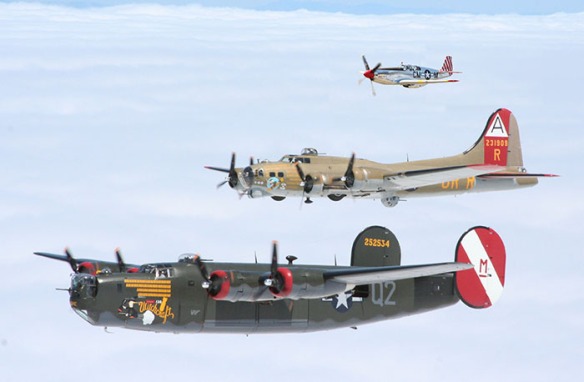There is no question that the Boeing B-17 had better press-and a better name- than the Consolidated B-24. “Flying Fortress” evoked a vision of impregnability, while “Liberator” was much more abstract. The B-17 was indeed more of a fortress than was the B-24, but their respective crews defended their aircraft with passion-and in the case of the B-24, with a dash of derring-do attitude.
The B-17 was the older design, conceived by Boeing in 1934, with the first 13 planes delivered to what was then the Army Air Corps in 1938. Consolidated Aircraft Corporation-the 1923 successor to the Dayton-Wright Airplane Company-birthed the B-24 in 1939 as the next generation heavy bomber to supplant the Boeing XB-15, Douglas XB-19 and B-17.
The Lib was faster: 215 mph cruising speed for the B-24J, for example, versus 182 for the B- 17C. The Lib’s gracefully tapered 100-foot Davis airfoil wing (compared to the B-17’s 103-foot-span barn door of a wing) made the difference. The Lib had a larger bomb bay and a somewhat longer range. So it flew faster, farther and carried more bombs than the B-17. I trained on both the B-24 and the B-17 at the aerial gunnery school in Tyndall, Fla. Like my classmates, I fervently hoped to be assigned to B-17s. They were reputedly able to withstand punishment that would down a Lib. That reputation was substantiated by battle damage photos of B- 17s riddled by flak and fighter fire that had still managed to return to base. Not many photos of similarly damaged but surviving B-24s showed up. The Libs didn’t have that big low-aspect-ratio wing to sustain lift after serious aerodynamic damage. Also, enemy fighter pilots had discovered that a concentrated burst into the cross-feed fuel tines between the B-24’s shoulder high wing roots could be fatal.
On the liberator’s plus side, its tricycle landing gear made taxiing, takeoff and landing easier than the B-17’s conventional tailwheel configuration. The B-24 pilot’s seat was more comfortable too, with its six-way adjustments. A peculiar B-17 drawback was its parking brake control, accessible only to the co-pilot.
With some minor variants, the two bombers had comparable armament: nose turrets (beginning on the B-17 with the G model’s chin turret), top and ball turrets and waist window guns. The tail armament differed: a fully revolving power turret in the B-24, a less mobile turret in the B-17. The B-24’s ball turret retracted fully into the fuselage until it was lowered for action. The B-17’s ball turret rode about three-fourths permanently extended. For a belly landing, the gunner was helped out of his position, after which the ball was jettisoned.
In the event of ditching, there was no contest. That low B-17 wing could serve as a temporary pontoon while the crew scrambled into life rafts. The B-24’s high wing put the fuselage underwater- often badly damaged. Crew members, if they escaped at all, had to swim out.
The B-24, with its big slab-sided fuselage, said one contemporary pilot, “looked like a truck, hauled big loads like a truck and flew like a truck.” As a B-24 passed overhead in plain view, though, it was apparent that the fuselage was narrower, and that long, tapered wing lent the Liberator a deceptive gracefulness. Though more than 19,000 B- 24s were built-more than any other American wartime aircraft-the older, slower but tougher Fortress got the press glory.
Sporting shiny new gunner’s wings, I was assigned to the bomber I didn’t want-a B-24. Yet those of us on “B-Dash- Two-Crash-Fours” came to feel a degree of bravado in riding such a beast. As for my crew, a truly gleeful moment came when we spotted a lone B-17 ahead, lumbering along the Adriatic’s shoreline on a 1945 routine training flight-just as we were at the time. Our pilot gained a bit of altitude, then nosed down in a shallow dive, leveled out and derisively lowered the wheels. We sailed past the Fortress, waving good-bye, then pulled far ahead and out of sight.
William Hallstead, who writes from Sanibel Island, Fla., served as a B-24 radioman/ gunner with the 456th Bomb Group in Italy Suggested reading: Flying School: Combat Hell, by Ellis M. “Woody” Woodward
Postscript
In the final analysis, there is no real way to determine if either the B-24 or the B-17 was truly superior. But, the record of the two types indicates that, of the two, the Liberator design was more versatile and considerably more advanced than that of the Flying Fortress. The combat records of both types contradict the assertions that aircrews flying B-17s were “safer” than those in B-24s. The argument as to which was the best can never be settled. As long as there are still two surviving heavy- bomber veterans, one from each type, the B-17 veteran will believe his airplane was best, while the B-24 vet will know better.
